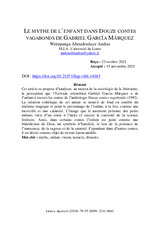Le mythe de l’enfant dans Douze contes vagabonds de Gabriel García Márquez
The myth of the child in Strange Pilgrims by Gabriel García Márquez
Autor
Andou, Weinpanga Aboudoulaye
Editor
Cultural Association Littera ApertaFecha
2018Materia
MytheEnfant
Vision
Miracle
Désastre
Myth
Child
Vision
Miracle
Disaster
METS:
Mostrar el registro METSPREMIS:
Mostrar el registro PREMISMetadatos
Mostrar el registro completo del ítemResumen
This article aims to analyze, through the sociology of literature,t he viewpoint that the Columbian writer Marquez has onthe child through the stories included in Strange Pilgrims(1992).The aesthetic creation of this author is fed from top to bottom with magical realism. These short stories portray the character of the child, on the one hand as wonder and on the other hand as a calamity. The image the narrator presents of the children changes from one story to the other and it arouses the interest of the literary science. In some stories, the child is portrayed as God’s benediction, a symbol of humility, the place of innocence, wisdom, and holiness. However, in other stories, heor sheis described as an awful object of terror. Cet article se propose d’analyser, au moyen de la sociologie de la littérature, la perception que l’écrivain colombien Gabriel García Márquez a de l’enfant à travers les contes de l’anthologie Douze contes vagabonds(1992).La création esthétique de cet auteurse nourrit de fond en comble du réalisme magique et peintle personnage del’enfant, à la fois, comme une merveille et une calamité. L’image que le narrateur présente des petits enfants varie d’un conte à l’autre et suscite la curiosité de la science littéraire. Ainsi, dans certains contes l’enfant est peint comme une bénédiction de Dieu, un symbole d’humilité, le lieu de la présence de l’innocence, de la sagesse et de la sainteté. Cependant dans d’autres contes, il est décrit comme objet deterreur épouvantable.

